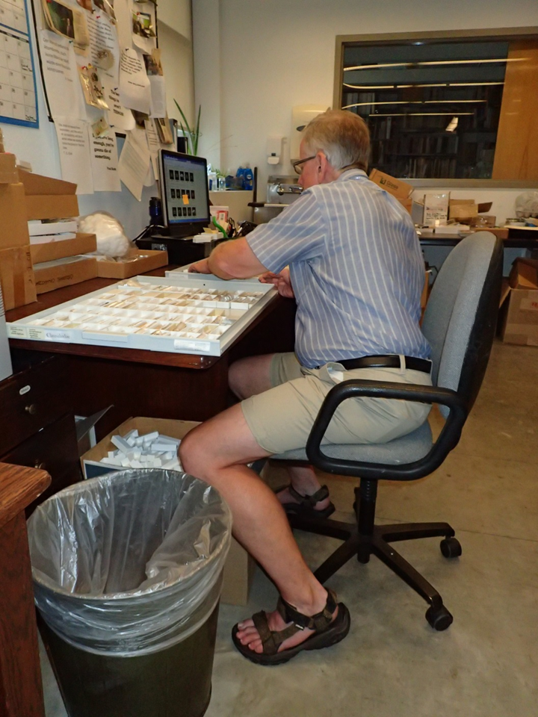By Charles F. Sturm and Timothy A. Pearce

Volunteer Dan Cornell helps to sort and distribute specimens to their proper places in the research collection.
Scientists from around the world converged at the joint meeting of the American Malacological Society and the Western Society of Malacologists in Honolulu for a symposium on Museums and Modern Society on 21st of June 2018. One topic covered the importance of volunteers in Museums. Our paper in the symposium, entitled, “Without volunteers, collections as we know them could not exist,” highlighted some of the myriad ways volunteers play vital roles in the section of mollusks.
Volunteers provide essential efforts in the process of acquiring, sorting specimens from matrix, identifying and updating identifications, rehousing, labeling, cataloging and databasing, distributing
(shelving), and organizing.
One example of the crucial role of volunteers is the incorporation of the extensive Aldrich collection (collected pre-1953) into our research collection. The Aldrich collection, sent to us from California,
included material from around the world and most of it was housed in non-archival boxes. Volunteers recorded locality information for each lot, re-housed the specimens in archival vials and trays, updated the nomenclature, and then distributed the specimens into the collection. In total some 17,000 lots were processed, by dedicated volunteers, over a six-year period. The specimens are now housed in their proper places in the research collection, and the information is available on the internet.
In another example, Carnegie Museum received, in 1931, a large donation from the research
of Herman Wright. This material sat unprocessed for 9 decades and over the past few years, is being curated to be more accessible to scientists. While most of the lots have locality numbers, the original data cards were lost, so the meaning of most of the locality numbers was unknown. Volunteers have recovered approximately 80% of the locality information from some lots that did have locality data with the locality numbers, from reviewing published literature, and from other sources of information such as archival records. These efforts are allowing us to incorporate this material into the collection.
Another example of the necessity of volunteers is the Pennsylvania Land Snail Atlas Project. Volunteers have helped by collecting samples from around Pennsylvania and assisting with other field collecting. Volunteers accomplished a major part of picking minute snails (mostly less than 3 mm or 1/8 inch) from leaf litter samples. Following identification and cataloging of the specimens, volunteers distributed them to their proper places in the research collection and helped upload the information to the internet. This material is readily available for study by amateur and professional naturalists. These efforts have facilitated the production of updated distribution maps of Pennsylvania land snails, as well as imperilment ranks (how rare or secure they are).
These are some of the many projects that could not have been accomplished without the vital assistance of many men and women volunteers over the years.
Teens, college students, and adults of all ages may become volunteers to support almost every department at Carnegie Museum of Natural History. Learn more about volunteering at carnegiemuseums.org.
